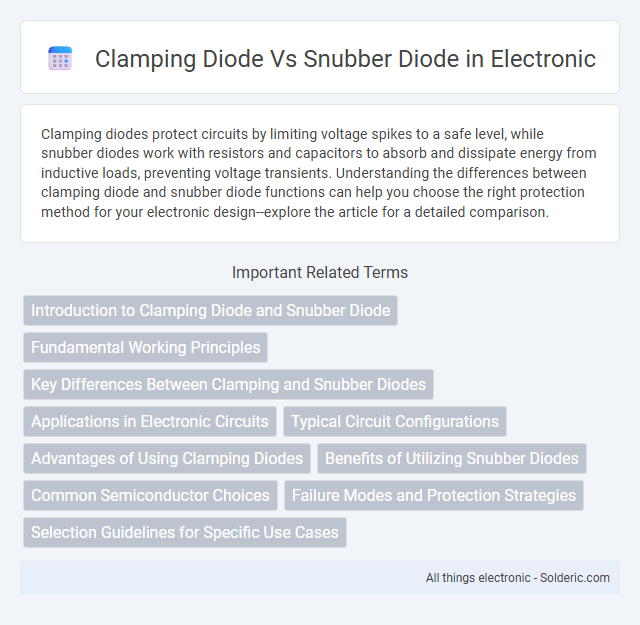Clamping diodes protect circuits by limiting voltage spikes to a safe level, while snubber diodes work with resistors and capacitors to absorb and dissipate energy from inductive loads, preventing voltage transients. Understanding the differences between clamping diode and snubber diode functions can help you choose the right protection method for your electronic design--explore the article for a detailed comparison.
Comparison Table
| Feature | Clamping Diode | Snubber Diode |
|---|---|---|
| Primary Purpose | Protects circuits by limiting voltage spikes | Damps voltage transients and absorbs energy |
| Typical Application | Across inductive loads or relay coils | Part of snubber circuit across switching devices |
| Operation Mode | Conducts during voltage spike (flyback) | Conducts to dissipate energy in transient event |
| Component Configuration | Simple diode connected reverse across inductive element | Usually diode plus resistor/capacitor in snubber circuit |
| Voltage Spike Control | Clamps voltage to diode forward drop level | Reduces rate of voltage rise (dv/dt) and peak spike |
| Energy Dissipation | Minimal energy dissipation; stores energy in load | Consumes energy in resistor and/or capacitor |
| Typical Components Used | Standard diode (e.g., 1N4007, 1N4148) | Fast recovery diode with resistor and capacitor |
| Advantages | Simple, cost-effective protection | Improved transient suppression and device protection |
| Disadvantages | Limited transient energy absorption | Complexity and additional component cost |
Introduction to Clamping Diode and Snubber Diode
Clamping diodes protect electronic circuits by limiting voltage spikes to a safe level, commonly used in inductive load switching to prevent damage from transient voltage. Snubber diodes serve a similar purpose but are part of an RC snubber circuit designed to absorb and dissipate energy, smoothing voltage spikes and reducing electromagnetic interference (EMI). Both play critical roles in safeguarding semiconductor devices by controlling voltage transients and enhancing circuit reliability.
Fundamental Working Principles
Clamping diodes protect electronic circuits by limiting voltage spikes through direct conduction when voltage exceeds a certain threshold, effectively shunting excess voltage away from sensitive components. Snubber diodes, often part of an RC snubber circuit, absorb transient energy and reduce voltage spikes across inductive loads by controlling the rate of voltage change (dv/dt), thus enhancing circuit robustness. Both diodes serve to prevent damage from inductive kickback but operate differently: clamping diodes act as voltage limiters, while snubber diodes manage transient energy dissipation.
Key Differences Between Clamping and Snubber Diodes
Clamping diodes protect circuits by limiting voltage spikes to a predefined threshold, effectively preventing damage from transient overvoltages. Snubber diodes, integrated with resistors or capacitors, dissipate energy from inductive loads, reducing voltage spikes and oscillations during switching events. The primary difference lies in clamping diodes focusing on voltage limitation, while snubber diodes emphasize controlled energy dissipation and suppression of voltage transients.
Applications in Electronic Circuits
Clamping diodes are primarily used to protect sensitive components by limiting voltage spikes in electronic circuits, often found in power supplies and signal lines. Snubber diodes, commonly integrated with snubber circuits, are essential in controlling voltage transients and dissipating energy in inductive loads such as motors and relays. Your choice between a clamping diode and a snubber diode depends on the specific application requirements for transient voltage suppression and energy absorption in the circuit.
Typical Circuit Configurations
Clamping diode circuits typically connect the diode in parallel with the inductive load, allowing it to conduct when the voltage spike exceeds the supply voltage, thereby protecting switching devices from high-voltage transients. Snubber diode configurations often involve the diode in series with a resistor or RC network across the switch or load, dissipating energy more gradually and reducing voltage spikes. Your choice between clamping and snubber diodes depends on specific circuit requirements for transient voltage suppression and energy dissipation.
Advantages of Using Clamping Diodes
Clamping diodes provide efficient protection by limiting voltage spikes and preventing damage to sensitive electronic components, enhancing circuit reliability. Their simple design enables quick response times and low power losses compared to snubber diodes. You benefit from improved durability and reduced maintenance costs when incorporating clamping diodes in voltage transient suppression applications.
Benefits of Utilizing Snubber Diodes
Snubber diodes protect switching devices from voltage spikes by dissipating transient energy, improving circuit reliability and longevity. Their ability to absorb inductive kickback reduces electromagnetic interference (EMI) and prevents voltage overshoot, ensuring stable operation of your power electronics. Compared to clamping diodes, snubber diodes offer enhanced suppression of switching noise and better control of transient voltage conditions.
Common Semiconductor Choices
Clamping diodes and snubber diodes commonly employ silicon-based semiconductors such as silicon rectifiers and Schottky diodes for their fast switching capabilities and low forward voltage drop. Silicon carbide (SiC) and gallium nitride (GaN) diodes are increasingly used in high-voltage or high-frequency applications due to their superior thermal conductivity and higher breakdown voltage. Selection depends on application-specific parameters including voltage rating, switching speed, and thermal management requirements.
Failure Modes and Protection Strategies
Clamping diodes primarily prevent voltage spikes by limiting overvoltage conditions, protecting semiconductor devices from damage caused by inductive load switching, while failure typically occurs due to diode overheating or breakdown under sustained high energy. Snubber diodes, integrated within RC snubber circuits, absorb transient energy and reduce voltage spikes by dissipating energy safely, with failure modes often linked to component stress or improper snubber design leading to insufficient damping. Your circuit protection strategy should select the appropriate diode type based on load characteristics and transient energy levels to minimize failure risks and enhance device reliability.
Selection Guidelines for Specific Use Cases
Clamping diodes are ideal for protecting sensitive circuits by limiting voltage spikes in inductive loads, making them a preferred choice in relay and motor driver applications. Snubber diodes, integrated with resistors or capacitors, excel in absorbing transient energy in high-speed switching environments like power electronics and switching regulators. When selecting your diode, prioritize the voltage and current ratings specific to your load type and switching frequency to ensure optimal protection and efficiency.
Clamping diode vs snubber diode Infographic

 solderic.com
solderic.com